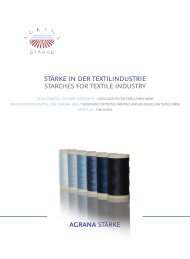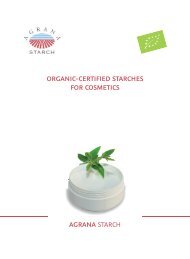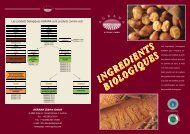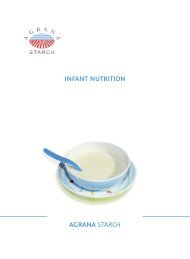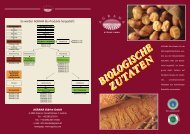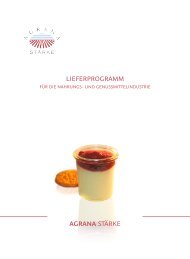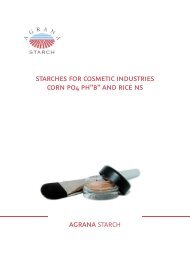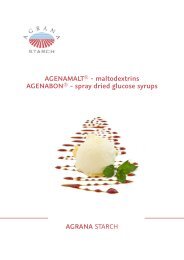AGRANA rice starch
AGRANA rice starch
AGRANA rice starch
Create successful ePaper yourself
Turn your PDF publications into a flip-book with our unique Google optimized e-Paper software.
STARCHES FOR COSMETIC INDUSTRIES<br />
<strong>AGRANA</strong>´S RICE STARCHES<br />
<strong>AGRANA</strong> STARCH
<strong>AGRANA</strong>’S RICE STARCHES<br />
THE FINEST BOTANICAL POWDERS FOR COSMETICS<br />
<strong>AGRANA</strong> Stärke GmbH has a broad range of experience with <strong>rice</strong> <strong>starch</strong>es in personal care. <strong>AGRANA</strong>’s name is<br />
synonymous with refi nement of NATURAL, RENEWABLE RAW MATERIALS.<br />
HISTORY OF RICE STARCH USAGE FOR COSMETICS<br />
In 1500 BC Chinese women used cosmetics to create and enhance the look of<br />
arched eyebrows. The eyebrows were shaded a green hue fi nished with powdered<br />
<strong>rice</strong> <strong>starch</strong>. In the fi rst millennium, AD women in the Far East covered their faces<br />
with a powder derived from <strong>rice</strong> fl our to make their complexions appear white as<br />
porcelain. In Japan, both men and women commonly applied this type of face powder<br />
as a sign of aristocracy and a symbol of pure internal beauty.
PARTICLE SIZE<br />
Due to the fi ne particle size, <strong>rice</strong> <strong>starch</strong>es are among the smallest of the vegetable powders, measuring 7-9 μm. This<br />
inherent fi neness results in an extraordinary increase in surface area. Approximately 1.0 g has a surface area of 1.6<br />
m² resulting in extraordinary adsorption and absorption characteristics.<br />
Fig. 1 microscope, zoom 1:500<br />
POTATO STARCH CORN STARCH RICE STARCH<br />
The shape, size and appearance of <strong>AGRANA</strong> <strong>rice</strong> <strong>starch</strong> products are equivalent to those of native <strong>rice</strong> <strong>starch</strong>es. They<br />
are much fi ner than corn or potato derived products and as a result the <strong>rice</strong> based products exhibit an<br />
extraordinary soft-touch eff ect. <strong>AGRANA</strong> <strong>rice</strong> <strong>starch</strong>es are thus ideal to optimally cover today’s demands on both<br />
decorative cosmetics as well as those for skin and hair care.<br />
Fig. 2: particle size distribution<br />
Particle Size (in μm)<br />
Volumina (%)
THE PRODUCT FAMILY OF THE <strong>AGRANA</strong> RICE STARCHES<br />
RICE NS + P.F.A. 11<br />
Naturally hydrophilic, cross-linked <strong>starch</strong>es based on <strong>rice</strong>, Non-Swelling<br />
INCI: Dimethylimidazolidinone <strong>rice</strong> <strong>starch</strong><br />
EINECS: 232-679-6<br />
RICE NS and P.F.A. 11 are produced from selected grades of <strong>rice</strong> and cross-linked using a highermolecular dimethylethylene<br />
urea derivate. P.F.A. 11 is chemically identical to RICE NS but subjected additionally to a special sieving<br />
process (sieving at 45 μm), so that a trouble-free usage in spray applications is guaranteed to prevent clogging.<br />
Both are hydrophilic and fully resistant to boiling, non-toxic, do not stick or form a paste. They are insoluble in most<br />
solvents and stable at pH 3.5+.<br />
FAQ: SAFETY STATUS OF DIMETHYLIMIDAZOLIDINONE RICE STARCH<br />
RICE NS is Dimethylimidazolidinone Rice <strong>starch</strong> and is manufactured by using 1,3-Dimethyl-4,5-dihydroxy-imidazolidin-2one<br />
which does not release any formaldehyde.<br />
Frequently it is mixed up with similar sounding chemical names.<br />
1,3-Dimethyl-4,5-dihydroxy-imidazolidin-2-one (CAS 3923-79-3) is used as a reagent for cross-linking and is completelydi� erent<br />
from imidazolidinyl urea (CAS 39236-46-9) or diazolidinyl urea (CAS 78491-02-8) which are based on di� erent chemical<br />
structures, properties and uses and therefore must be di� erentiated.<br />
No formaldehyde will be released by RICE NS + P.F.A. 11.
APPLICATIONS IN DECORATIVE COSMETICS<br />
• compact powders (fine powders which gently mattes and fixes makeup)<br />
• eye liners & brow definers<br />
• volumizing mascara<br />
• loose powders<br />
• aerosols (P.F.A. 11)<br />
Benefits of using RICE NS und P.F.A. 11 in decorative cosmetics:<br />
• The microcrystalline structure of RICE NS provides the skin with a natural matt shimmer as found with a normal<br />
non-greasy skin. This is a notable advantage for powder make-up, as the transition between the powdered<br />
and the non-powdered skin areas remain invisible.<br />
• Because of the extraordinary fine particle size (7-9 μm), RICE NS and P.F.A.11 exhibit extraordinary soft-touch.<br />
The large surface area permits a fine distribution of both functional and active ingredients and also guarantees<br />
effective delivery to the skin.<br />
APPLICATIONS IN EMULSIONS<br />
• creams and lotions<br />
• refresching gels<br />
RICE NS is mixed into the aqueous phase. High temperatures from 70°C and above are beneficial and the <strong>starch</strong><br />
particles adsorb and absorb parts of the phase. RICE NS can also be pre-dispersed in propylene glycol or an oil and<br />
thus easily added to the water phase.<br />
40 0 c 50 0 c 60 0 c 70 0 c 80 0 c 90 0 c<br />
The illustration shows the result with RICE NS in a sedimentation test (10 g of product are stirred in 100 ml water<br />
and the temperature is raised in increments from 40°C – 90°C): The suspension is filled into a cylinder after 15<br />
minutes whereby the <strong>starch</strong> can settle out. This method illustrates the swelling and absorption capacity of <strong>starch</strong>es<br />
during the emulsification.<br />
Fig. 3:<br />
sedimentation test
Benefi ts of using RICE NS in emulsions cosmetics:<br />
• Enhanced e� cacy of active ingredients<br />
• Long-lasting moisturizing eff ect<br />
• Improved spreading properties of the emulsion<br />
• pleasant and silky-soft touch<br />
• Mattifying eff ect<br />
in emulsions RICE NS reduces the shininess on the skin caused by diff erent lipophilic ingredients present in<br />
emulsions (vegetable oils and butters, petrolatum, para� n oils, waxes)<br />
• In natural antiperspirant agents RICE NS adsorbs perspiration released by the skin. The pores are not blocked<br />
because the particles do not swell on the skin. There is no whitening eff ect of the product applied on the skin.<br />
Evidence has shown that the dispersed <strong>starch</strong> particles do not precipitate and remain evenly<br />
distributed, even after long storage.<br />
D.S.A. 7 (= DRY SHAMPOO AEROSOL)<br />
INCI: Oryza Sativa and Cetrimonium Chloride<br />
EINECS: 232-679-6 + 203-928-6<br />
D.S.A. 7 is a natural active for dry hair shampoos based on a soft, surface-active <strong>rice</strong> <strong>starch</strong> with a<br />
particle size of approx. 8 μm and control sieved at 45 μm.<br />
D.S.A.7 is free fl owing and neither sticks to the can walls nor forms lumps. It remains soft in the stem,<br />
valve system including the orifi ce and actuators. Even after long periods of storage, the loose<br />
sediment can be fi nely dispersed again by lightly shaking.<br />
Benefi ts of using D.S.A. 7 in dry shampoos:<br />
• high adsorption for oil and fat<br />
• removes the grease of the hair<br />
• can be easily brushed out of the hair<br />
• gives a quick cleansing eff ect<br />
• results in shiny, airy and fresh hair<br />
An optimum aerosol can fi lling would contain 6 - 8% of D.S.A.7 ® , 0.2-0.4% perfume and an aerosol<br />
propellant.<br />
REACH-STATUS<br />
Our <strong>rice</strong> <strong>starch</strong>es and modifi ed <strong>rice</strong> <strong>starch</strong>es are excluded from mandatory REACH-registration.
<strong>AGRANA</strong>. THE NATURAL UPGRADE.<br />
<strong>AGRANA</strong> Starch / <strong>AGRANA</strong> Stärke GmbH<br />
Mr. Anton Amon<br />
A-3950 Gmünd, Conrathstrasse 7, Austria<br />
Tel.: +43/2852/503-0<br />
Fax: +43/2852/503-19360<br />
e-mail: anton.amon@agrana.com<br />
www.agrana.com<br />
This paper contains <strong>starch</strong> produced by <strong>AGRANA</strong>!



